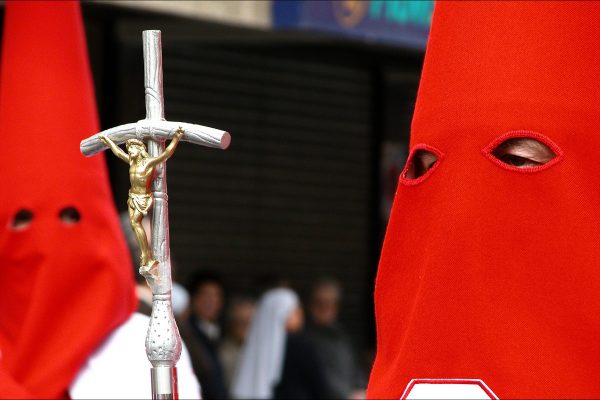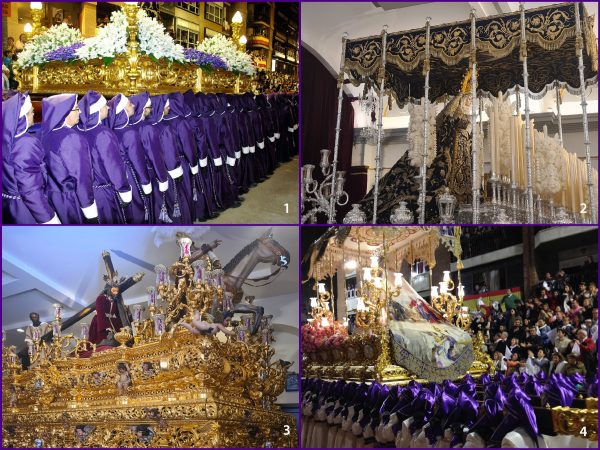
Die Prozessionen der Karwoche (Semana Santa, Heilige Woche) sind der Höhepunkt des Kirchenjahres im katholischen Spanien. Am bekanntesten sind die Prozessionen von Sevilla, die von ca. 70 Bruderschaften (Hermandades/Cofradías) organisiert werden. Wichtiger Bestandteil sind die Pasos, die Marien- oder Jesusstatuen, die über 1000 kg wiegen können und von jeweils 35 bis 50 starken Männern (Costaleros) durch die Stadt getragen werden. Begleitet werden sie von Büßern mit ihren Spitzhauben (Nazarenos) und von Musikkapellen.
Weil es an Nachwuchs bei den Costaleros mangelt, werden öfter bezahlte Träger angeheuert. Außerdem wird versucht, das Gewicht der Pasos zu reduzieren. Die entsprechende Bekleidung zur Teilnahme an den Prozessionen schlägt mit ca. 500 Euro zu Buche, das Mieten eines Balkons mit direkter Sicht auf die Prozession kostet in Sevilla 1.000 bis 2.000 Euro. Neueste Geschäftsidee sind die Sammelbilder (cromos, HolyCards) mit Figuren der Karwoche, die millionenfach von Jung und Alt gekauft und dann bei öffentlichen Tauschbörsen getauscht werden.
Die Semana Santa mit ihren Bräuchen und Prozessionen betrachte ich persönlich als eine Mischung aus Tradition, Kunst und Frömmigkeit mit Geschäft, Folklore und Volksglaube. Aus biblischer Sicht sind die Bußpraktiken sowie die Verehrung von Bildern, Heiligen und Reliquien zu hinterfragen. Fatal ist es, wenn das alles vom Zentrum des Evangeliums ablenkt: die Erlösung durch den Glauben (und nicht durch die Werke), die Auferstehung (und nicht fast ausschließlich die Kreuzigung) und die Wiederkunft Christi (die im Kirchenjahrkalender völlig fehlt).
Fotos:
1) Prozession in Lorca (Foto: jacqueline macou, pixabay.com)
2) Paso de la Esperanza Macarena in Sevilla (Foto: Marta López Díez)
3) Paso de la Esperanza de Triana in Sevilla (Foto: Marta López Díez)
4) Prozession in Lorca (Foto: jacqueline macou, pixabay.com)
Fotos:
1) Paso Jungfrau der Tränen in Malaga (Foto: alejandrocuencac, pixabay.com)
2) Der Gekreuzigte (Foto: Joanjo Puertos Munoz, pixabay.com)
3) Die Abnahme vom Kreuz (Foto: Jose B. Garcia Fernandez, pixabay.com)
4) Costaleros (Foto: Gary C., pixabay.com)
![]()
Piety and folklore: Semana Santa
The processions of Holy Week (Semana Santa, Holy) are the highlight of the church year in Catholic Spain. The best known are the processions of Seville, which are organised by about 70 brotherhoods (Hermandades/Cofradías). An important part of the procession are the pasos, the statues of Mary or Jesus, which can weigh over 1000 kg and are carried through the city by 35 to 50 strong men (costaleros). They are accompanied by penitents with their pointed caps (Nazarenos) and by music bands.
Because there is a lack of new costaleros, paid porters are hired more often. In addition, attempts are made to reduce the weight of the pasos. The cost of clothing for participation in the processions is around 500 euros, and renting a balcony with a direct view of the procession costs 1,000 to 2,000 euros in Seville. The latest business idea are the collectible pictures (cromos, HolyCards) with figures of the Holy Week, which are bought by the millions by young and old and then exchanged at public exchanges.
I personally see the spanish Semana Santa with its customs and processions as a mixture of tradition, art and piety with business, folklore and popular belief. From a biblical point of view, the penitential practices as well as the veneration of images, saints and relics are to be questioned. What is fatal is when all this distracts from the centre of the Gospel: salvation by faith (and not by works), the resurrection (and not almost exclusively the crucifixion) and the return of Christ (which is completely missing in the church year).
![]()
Religiosidad y folclore: la Semana Santa
Las procesiones de Semana Santa son el momento culminante del año eclesiástico en la España católica. Las más conocidas son las procesiones de Sevilla, organizadas por unas 70 Hermandades/Cofradías. Elemento importante de las procesiones son los pasos, las estatuas de María o Jesús, que pueden pesar más de 1.000 kg y son llevados por la ciudad por entre 35 y 50 hombres fuertes (costaleros). Los acompañan penitentes con sus capirotes puntiagudos (nazarenos) y bandas de música.
Debido a la falta de nuevo personal entre los costaleros, cada vez se contratan más pagándoles. Además, se intenta reducir el peso de los pasos. El coste de la ropa para participar en las procesiones ronda los 500 euros, y alquilar un balcón con vistas directas a la procesión cuesta en Sevilla de 1.000 a 2.000 euros. La última idea de negocio son los cromos (HolyCards) con figuras de Semana Santa, que son comprados por millones por jóvenes y mayores y luego intercambiados en bolsas públicas.
Personalmente veo la Semana Santa con sus costumbres y procesiones como una mezcla de tradición, arte y piedad con negocio, folklore y creencia popular. Desde un punto de vista bíblico, las prácticas penitenciales, así como la veneración de imágenes, santos y reliquias, son cuestionables. Lo fatal es cuando todo esto distrae del centro del Evangelio: la salvación por la fe (y no por las obras), la resurrección (y no casi exclusivamente la crucifixión) y el retorno de Cristo (que falta por completo en el año eclesiástico).



